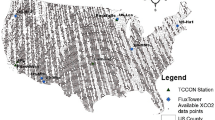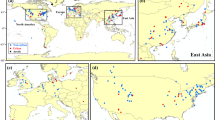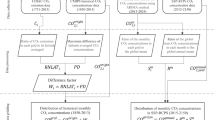Abstract
Atmospheric Oxygen (O2) is one of the dominating features that allow the earth to be a habitable planet with advanced civilization and diverse biology. However, since the late 1980s, observational data have indicated a steady decline in O2 content on the scale of parts-per-million level. The current scientific consensus is that the decline is caused by the fossil-fuel combustion; however, few works have been done to quantitatively evaluate the response of O2 cycle under the anthropogenic impact, at both the global and regional scales. This paper manages to quantify the land O2 flux and makes the initial step to quantificationally describe the anthropogenic impacts on the global O2 budget. Our estimation reveals that the global O2 consumption has experienced an increase from 33.69 ± 1.11 to 47.63 ± 0.80 Gt (gigaton, 109 t) O2 yr−1 between 2000 and 2018, while the land production of O2 (totaling 11.34 ± 13.48 Gt O2 yr−1 averaged over the same period) increased only slightly. In 2018, the combustion of fossil-fuel and industrial activities (38.45 ± 0.61 Gt O2 yr−1) contributed the most to consumption, followed by wildfires (4.97 ± 0.48 Gt O2 yr−1) as well as livestock and human respiration processes (2.48 ± 0.16 and 1.73 ± 0.13 Gt O2 yr−1, respectively). Burning of fossil-fuel that causes large O2 fluxes occurs in East Asia, India, North America, and Europe, while wildfires that cause large fluxes in comparable magnitude are mainly distributed in central Africa.
Similar content being viewed by others
References
Andres, R. J., T. A. Boden, and G. Marland, 2016: Annual fossilfuel CO2 emissions: Mass of emissions gridded by one degree latitude by one degree longitude. ORNL/CDIAC-97, NDP-058, Carbon Dioxide Information Analysis Center, Oak Ridge National Laboratory, U.S. Department of Energy, Oak Ridge, Tenn, 56 pp, doi: 10.3334/CDIAC/ffe.ndp058.2016.
Battle, M., M. Bender, T. Sowers, et al., 1996: Atmospheric gas concentrations over the past century measured in air from firn at the South Pole. Nature, 383, 231–235, doi: 10.1038/383231a0.
Bender, M. L., T. Sowers, J. M. Barnola, et al, 1994a: Changes in the O2/N2 ratio of the atmosphere during recent decades reflected in the composition of air in the firn at Vostok Station, Antarctica. Geophys. Res. Lett., 21, 189–192, doi: 10.1029/93GL03548.
Bender, M. L., T. Sowers, and L. Labeyrie, 1994b: The Dole Effect and its variations during the last 130,000 years as measured in the Vostok Ice Core. Global Biogeochem. Cycles, 8, 363–376, doi: 10.1029/94GB00724.
Bender, M. L., D. T. Ho, M. B. Hendricks, et al., 2005: Atmospheric O2/N2 changes, 1993-2002: Implications for the partitioning of fossil fuel CO2 sequestration. Global Biogeochem. Cycles, 19, GB4017, doi: 10.1029/2004GB002410.
Bopp, L., C. Le Quéré, M. Heimann, et al., 2002: Climate-induced oceanic oxygen fluxes: Implications for the contemporary carbon budget. Global Biogeochem. Cycles, 16, 6–1, doi: 10.1029/2001GB001445.
Cai, Q. X., X. D. Yan, Y. F. Li, et al., 2018: Global patterns of human and livestock respiration. Sci. Rep., 8, 9278, doi: 10.1038/s41598-018-27631-7.
Chen, S. Y., J. P. Huang, Y. Qian, et al., 2017: An overview of mineral dust modeling over East Asia. J. Meteor. Res., 31, 633–653, doi: 10.1007/s13351-017-6142-2.
Dintenfass, L., D. G. Julian, and G. V. F. Seaman, 1983: Heart Perfusion, Energetics, and Ischemia. Springer, Boston, MA, 663 pp, doi: 10.1007/978-1-4757-0393-1.
Frape, D., 2004: Equine Nutrition and Feeding (Third Edition). Blackwell Pub, Oxford, UK, 192–194.
Gidden, M. J., K. Riahi, S. J. Smith, et al., 2019: Global emissions pathways under different socioeconomic scenarios for use in CMIP6: A dataset of harmonized emissions trajectories through the end of the century. Geosci. Model Dev., 12, 1443–1475, doi: 10.5194/gmd-12-1443-2019.
Gilbert, M., G. Nicolas, G. Cinardi, et al., 2018: Global distribution data for cattle, buffaloes, horses, sheep, goats, pigs, chickens and ducks in 2010. Sci. Data, 5, 180227, doi: 10.1038/sdata.2018.227.
Henry, C. J. K., 2005: Basal metabolic rate studies in humans: Measurement and development of new equations. Public Health Nutr., 8, 1133–1152, doi: 10.1079/PHN2005801.
Huang, J. G., Y. Bergeron, B. Denneler, et al., 2007: Response of forest trees to increased atmospheric CO2. Crit. Rev. Plant Sci., 26, 265–283, doi: 10.1080/07352680701626978.
Huang, J. P., J. P. Huang, X. Y. Liu, et al., 2018: The global oxygen budget and its future projection. Sci. Bull., 36, 1180–1186, doi: 10.1016/j.scib.2018.07.023.
IPCC, 2006: 2006 IPCC Guidelines for National Greenhouse Gas Inventories, Chapter 3, National Greenhouse Gas Inventory Programme, Institute for Global Environmental Strategies, Hayama, Japan, 10–106.
IPCC, 2014: Climate Change 2013: The Physical Science Basis. Contribution of Working Group I to the Fifth Assessment Report of the Intergovernmental Panel on Climate Change. Cambridge University Press, New York. 121–140.
Ishidoya, S., S. Aoki, D. Goto, et al., 2012: Time and space variations of the O2/N2 ratio in the troposphere over Japan and estimation of the global CO2 budget for the period 2000-2010. Tellus B., 64, 18964, doi: 10.3402/tellusb.v64i0.18964.
Janssens-Maenhout, G., M. Crippa, D. Guizzardi, et al., 2019: EDGAR v4.3.2 global atlas of the three major greenhouse gas emissions for the period 1970-2012. Earth Syst. Sci. Data, 11, 959–1002, doi: 10.5194/essd-11-959-2019.
Jones, H., 2003: Design Rules for Space Life Support Systems. SAE Technical Paper 2003-01-2356, doi: 10.4271/2003-01-2356.
Keeling, R. F., 1988: Development of an interferometric oxygen analyzer for precise measurement of the atmospheric O2 mole fraction. PhD dissertation, Harvard University, Cambridge, 57–59.
Keeling, R. F., 2019: Atmospheric Oxygen Data for Alert, Cold Bay, Cape Kumukahi, La Jolla Pier, Mauna Loa Observatory, American Samoa, Cape Grim, Palmer Station and South Pole. [Available online at http://scrippso2.ucsd.edu/osub2sub-data].
Keeling, R. F., and A. C. Manning, 2014: Studies of recent changes in atmospheric O2 content. Treatise on Geochemistry. 2nd ed, H. D. Holland, and K. K. Turekian, Eds., Elsevier Ltd., Amsterdam, 385–405, doi: 10.1016/B978-0-08-095975-7.00420-4.
Keeling, R. F., A. Körtzinger, and N. Gruber, 2010: Ocean deoxygenation in a warming world. Annu. Rev. Mar. Sci., 2, 199–229, doi: 10.1146/annurev.marine.010908.163855.
Kleiber, M., 1932: Body size and metabolism. Hilgardia, 6, 315–353, doi: 10.3733/hilg.v06n11p315.
Le Quéré, C., R. M. Andrew, P. Friedlingstein, et al., 2018: Global carbon budget 2018. Earth Syst. Sci. Data, 10, 2141–2194, doi: 10.5194/essd-10-2141-2018.
Li, Y. C., Y. F. Xu, M. Chu, et al., 2012: Influences of climate change on the uptake and storage of anthropogenic CO2 in the global ocean. J. Meteor. Res., 26, 304–317, doi: 10.1007/s13 351-012-0304-z.
Liu, X. Y., J. P. Huang, J. P. Huang, et al., 2019: Anthropogenic oxygen flux from 1975 to 2012, link to NetCDF files. PANGAEA, doi: 10.1594/PANGAEA.899167.
Liu, Z., D. B. Guan, W. Wei, et al., 2015: Reduced carbon emission estimates from fossil fuel combustion and cement production in China. Nature, 524, 335–338, doi: 10.1038/nature 14677.
Luyssaert, S., I. Inglima, M. Jung, et al., 2007: CO2 balance of boreal, temperate, and tropical forests derived from a global database. Global Change Biol., 13, 2509–2537, doi: 10.1111/j.1365-2486.2007.01439.x.
Martin, D., H. McKenna, and V. Livina, 2017: The human physiological impact of global deoxygenation. J. Physiol. Sci., 67, 97–106, doi: 10.1007/s12576-016-0501-0.
Murakami, D., and Y. Yamagata., 2019: Estimation of gridded population and GDP scenarios with spatially explicit statistical downscaling. Sustainability, 11, 2106, doi: 10.3390/su 11072106.
Peters, W., A. R. Jacobson, C. Sweeney, et al., 2007: An atmospheric perspective on North American carbon dioxide exchange: CarbonTracker. Proc. Natl. Acad. Sci. USA, 104, 18,925-18,930, doi: 10.1073/pnas.0708986104.
Petsch, S. T., 2014: The global oxygen cycle. Treatise on Geochemistry. 2nd ed, H. D. Holland, and K. K. Turekian, Eds., Elsevier Ltd., Amsterdam, 437–473, doi: 10.1016/B978-0-08-095975-7.00811-1.
Plattner, G. K., F. Joos, and T. F. Stocker, 2002: Revision of the global carbon budget due to changing air-sea oxygen fluxes. Global Biogeochem. Cycles, 16, 1096, doi: 10.1029/2001gb 001746.
Royer, D. L., 2014: Atmospheric CO2 and O2 during the phanerozoic: Tools, patterns, and impacts. Treatise on Geochemistry. 2nd ed, H. D. Holland, and K. K. Turekian, Eds., Elsevier Ltd., Amsterdam, 251–267, doi: 10.1016/B978-0-08-095975-7.01311-5.
Shi, P. J., Y. Q. Chen, A. Y. Zhang, et al., 2019: Factors contribution to oxygen concentration in Qinghai-Tibetan Plateau. Chinese Sci. Bull., 64, 715–724, doi: 10.1360/n972018-00655.
Steinbach, J., C. Gerbig, C. Rödenbeck, et al., 2011: The CO2 release and oxygen uptake from fossil fuel emission estimate (COFFEE) dataset: Effects from varying oxidative ratios. Atmos. Chem. Phys., 11, 6855–6770, doi: 10.5194/acp-11-6855-2011.
Stolper, D. A., M. L. Bender, G. B. Dreyfus, et al., 2016: A Pleistocene ice core record of atmospheric O2 concentrations. Science, 353, 1427–1430, doi: 10.1126/science.aaf5445.
Tilman, D., J. Hill, and C. Lehman, 2006: Carbon-negative biofuels from low-input high-diversity grassland biomass. Science, 314, 1598–1600, doi: 10.1126/science.1133306.
Tohjima, Y., H. Mukai, Y. Nojiri, et al., 2008: Atmospheric O2/N2 measurements at two Japanese sites: Estimation of global oceanic and land biotic carbon sinks and analysis of the variations in atmospheric potential oxygen (APO). Tellus B., 60, 213–225, doi: 10.1111/j.1600-0889.2007.00334.x.
United Nations, Department of Economic and Social Affairs, Population Division, 2019: World Population Prospects 2019. Department of Economic and Social Affairs Population Division, New York, 374 pp.
Valentino, F. L., M. Leuenberger, C. Uglietti, et al., 2008: Measurements and trend analysis of O2, CO2 and δ13 C of CO2 from the high altitude research station Junfgraujoch, Switzerland— A comparison with the observations from the remote site Puy de Dôme, France. Sci. Total Environ., 391, 203–210, doi: 10.1016/j.scitotenv.2007.10.009.
van der Werf, G. R., J. T. Randerson, L. Giglio, et al., 2017: Global fire emissions estimates during 1997-2016. Earth Syst. Sci. Data, 9, 697–720, doi: 10.5194/essd-9-697-2017.
Walpole, S. C., D. Prieto-Merino, P. Edwards, et al., 2012: The weight of nations: An estimation of adult human biomass. BMC Public Health, 12, 439, doi: 10.1186/1471-2458-12-439.
Wang, R., S. Tao, P. Ciais, et al., 2013: High-resolution mapping of combustion processes and implications for CO2 emissions. Atmos. Chem. Phys., 13, 5189–5203, doi: 10.5194/acp-13-5189-2013.
Zhai, P. M., B. Q. Zhou, and Y. Chen, 2018: A review of climate change attribution studies. J. Meteor. Res., 32, 671–692, doi: 10.1007/s13351-018-8041-6.
Acknowledgments
We thank Julia Steinbach from Stockholm University and Christoph Gerbig from Max Planck Institute for Biogeochemistry for providing the CO2 release and oxygen uptake from fossil fuel emission estimate (COFFEE) dataset. We thank Shixue Li from Hokkaido University for his valuable suggestions on this work.
Author information
Authors and Affiliations
Corresponding author
Additional information
Supported by the National Natural Science Foundation of China (41521004) and China 111 Project (B13045).
Rights and permissions
About this article
Cite this article
Liu, X., Huang, J., Huang, J. et al. Estimation of Gridded Atmospheric Oxygen Consumption from 1975 to 2018. J Meteorol Res 34, 646–658 (2020). https://doi.org/10.1007/s13351-020-9133-7
Received:
Accepted:
Published:
Issue Date:
DOI: https://doi.org/10.1007/s13351-020-9133-7




